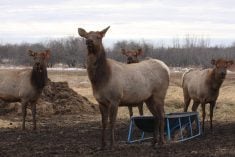ROULEAU, Sask. — Saskatchewan farmers are innovative and adaptable in their efforts to build a better discer, says an agriculture engineer.
Looking over a display of nearly 50-year-old discers, many of them farm-built, Hal Lewis said the discer was developed out of necessity.
“The one-way was hard to control and farmers were never happy with it … and the disc harrow was not heavy enough. It ridged and buried a lot of trash. Farmers were looking for a machine somewhere between the two,” said Lewis when a group of inventors, relatives and others involved with the evolution of Saskatchewan-made discs gathered at a permanent display of the implement.
Read Also

Why feds imposed EV tariffs
Moe and Kinew have a fight on their hands when it comes to eliminating the EV tariff. Canada has to worry about pissing off the U.S. and Mexico and hundreds of thousands of auto workers.
Lewis, a lecturer in agricultural engineering at the University of Saskatchewan from 1937 to 1962 and a farmer at Gray, said the major implement companies of the day were not making discers.
Avoid deep tillage
During the dry Thirties, deep tillage was not advised and many farmers thought a combination of the one-way and the disc harrow would create a machine that provided shallower tillage while leaving trash.
Lewis himself was one of many inventors who, through the late 1920s to the 1940s, developed their own versions of the discer in their barns and farm shops, despite a lack of good tools and materials.
By the mid- to late 1940s the major companies began manufacturing the implements, with and without seeding attachments.
At the display are discers bearing names like Weckman, Hansen, Hall, Helstrom, Lewis, Ursulescu, Kennedy, Gregg, Sakundiak and Kirby-McKinnon. Some built just one for their own use; others built several hundred.
Fred Schneider, of Eston, Sask., said John Deere and Cockshutt drew patterns of his discer in order to begin manufacturing their own. Lewis’s models were designed as prototypes for Canadian Co-operative Implements Ltd. Features of other models were often adopted by the major companies after viewing the implements at local field days.
There are other innovators and if their discers can be found they will be added to the display, said event organizer Clare Taylor, of Regina.















